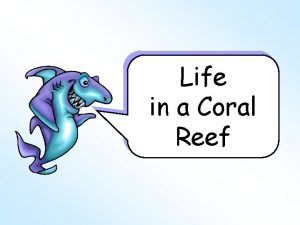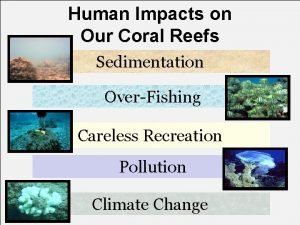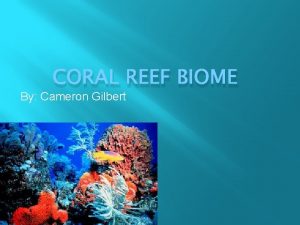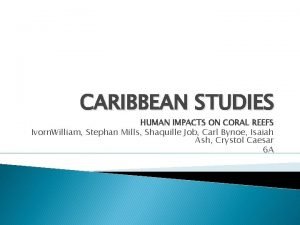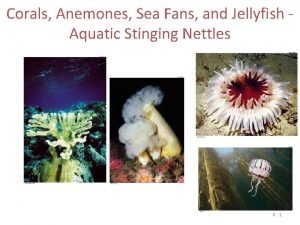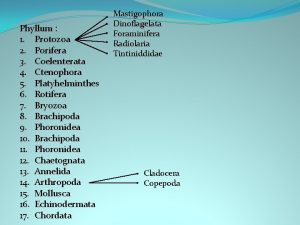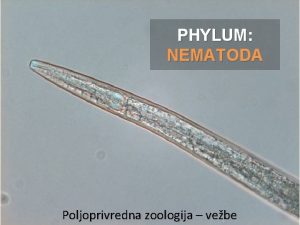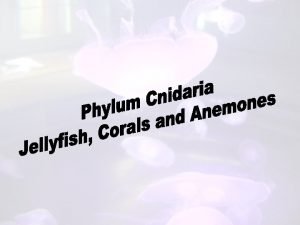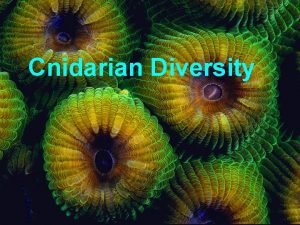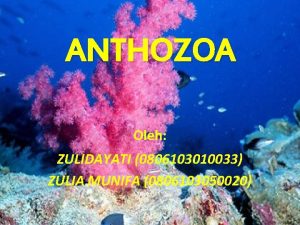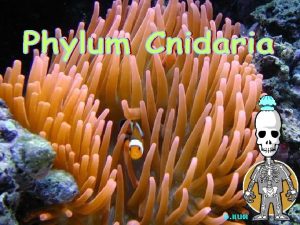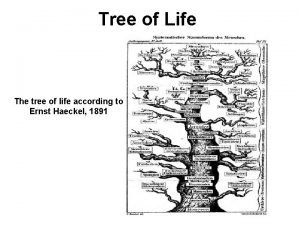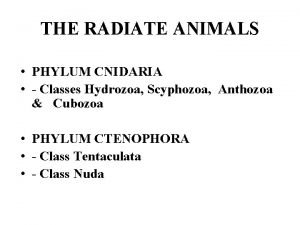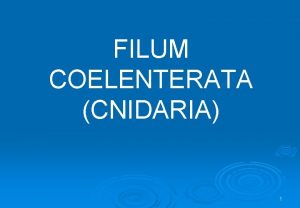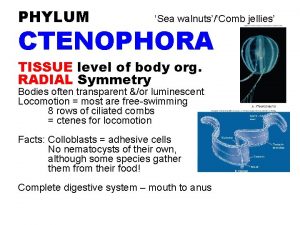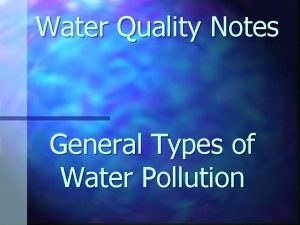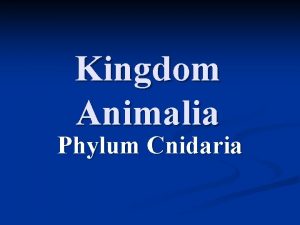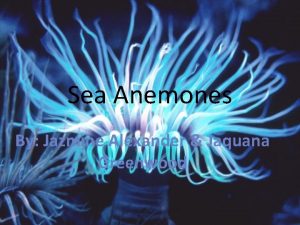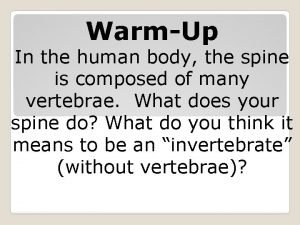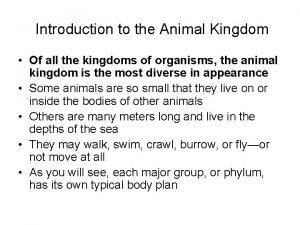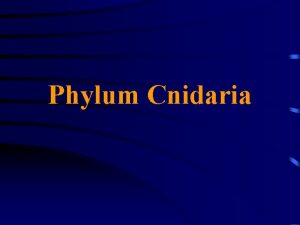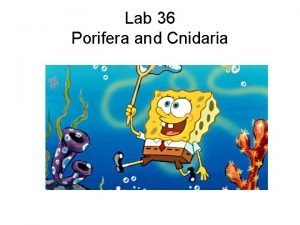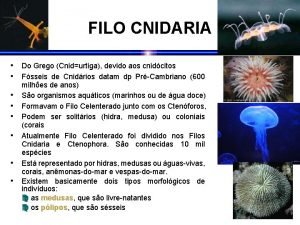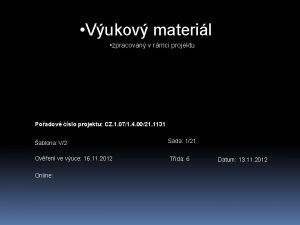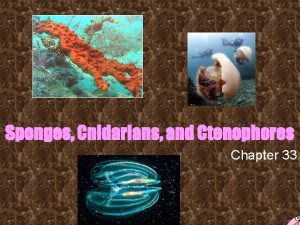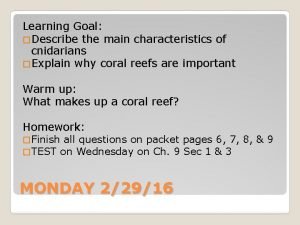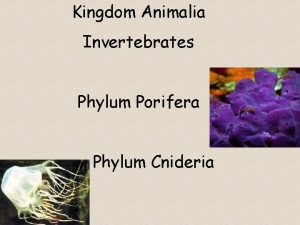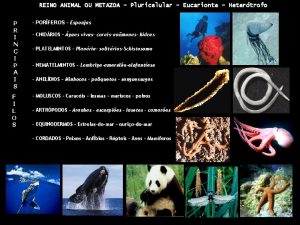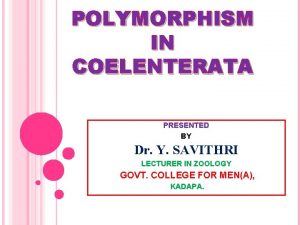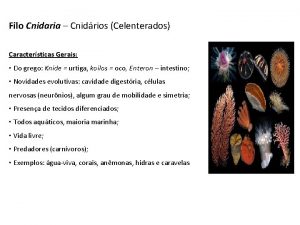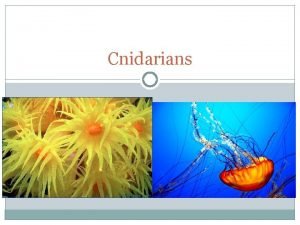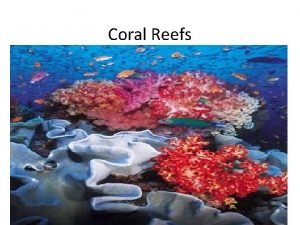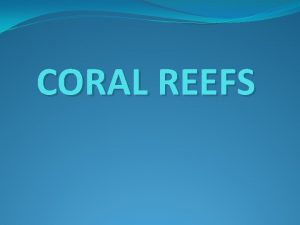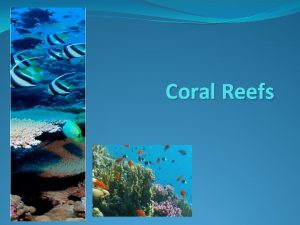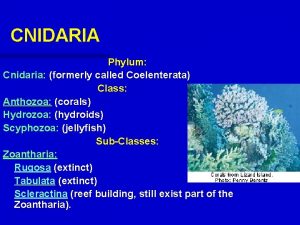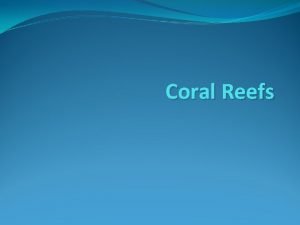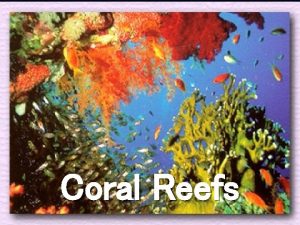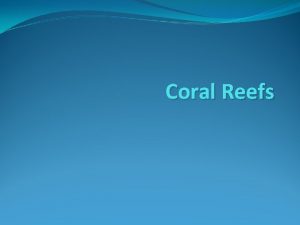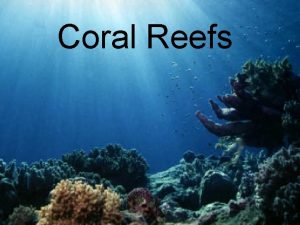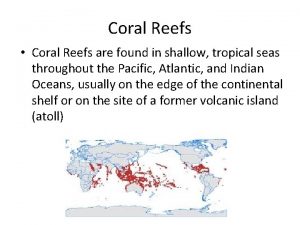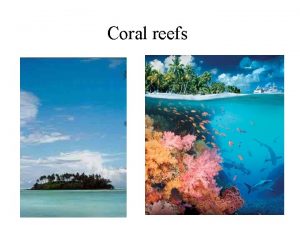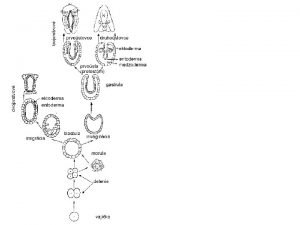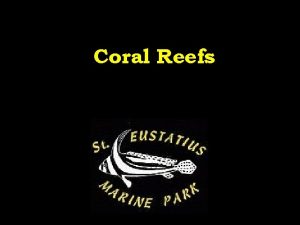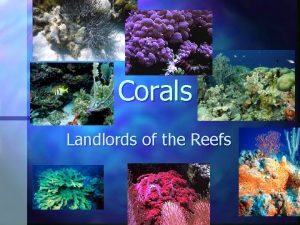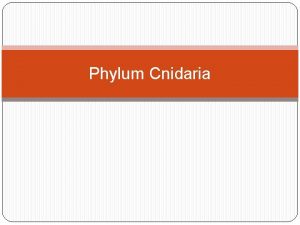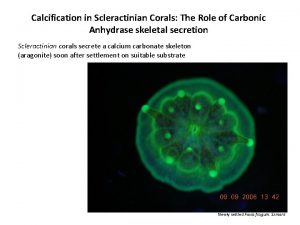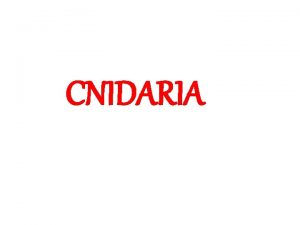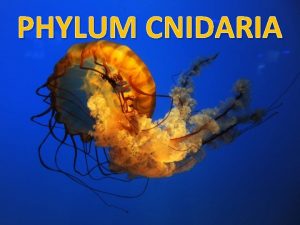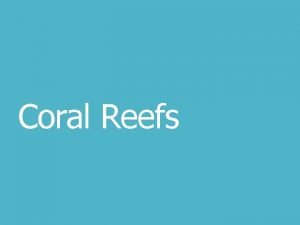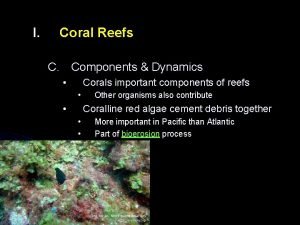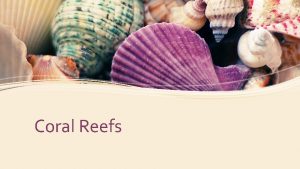Coral Reefs Scleractinian corals Phyllum Cnidaria Class Anthozoa












































- Slides: 44

Coral Reefs

Scleractinian corals • Phyllum Cnidaria – Class Anthozoa • Subclass Zoantharia – Order Scleractinia Only polyp phase (no medusae) Colonial organisms Ca. CO 3 exoskeleton Symbiosis with zooxanthellae

http: //krupp. wcc. hawaii. edu/



Cnidarian Polyp Antozoan corals form Reefs by accumulation of exoskeletons

Zooxanthellae • Non-motile naked dynoflagellates • Embedded in transparent polyps • Use corals wastes (CO 2 + nutrients) • Contribute 60% of primary production to polyp • Corals get ~50% energy from Zoox; ~50% from heterotrophic feeding

Scleractinian corals stats • Average Colony Age ~ 100 years • Growth rates ~ 0. 5 – 20 cm/year – Boulder corals slow growth (0. 5 -1) – Branching corals fast growth (10 -20) • Corals reefs – Originated in Triassic (220 mya) – Distributed between 24 o. N – 24 o. S latitude

Coral Reefs environmental requirements • Temperature (18 – 30 o. C) – Low Solubility of Ca. CO 3 at high temp. • Depth (0 -150 m) – Within photic zone – Below tide • Sedimentation – Low tolerance (prefer clear waters) • Salinity (33‰ and up) – Low tolerance of fresh water • Wave action – (high O 2, clear water and pelagic food supply)

Coral reef distribution and Diversity Indo. Pacific Diversity Eastern Ocean Dominance

Global Surface Currents

Chlorophyll Concentration

Ecosystem Productivity (Annual net productivity)

Coral reef productivity • Efficient Coral – Zooxanthellae simbiosis – Little loss of nutrients to water • Steep drop-offs promote increase pelagic productivity – Backreef eddies, local nutrient upwelling • Partially closed systems – high ammounts of benthic organic detritus

Fringe reefs Evolution of Coral Reefs (Darwin) Barrier reefs Atolls subsidence ~0. 03 mm/yr = 1, 200, 000 mm/40, 000 yr

1950 Enewetak





Cross-sections of various types of coral reefs

Turtle Grass Lagoon Sandy Lagoon

Patch reef lagoon

Reef flat

Reef crest

Reef crest – high wave energy


Shallow seaward reef

Shallow seaward reef – Acropora corals

Reef outer slope

Buttress Zone with sand channels

Outer reef wall

Coral Reef Zonation • Lagoon – Filled with sediments, corals grow or not according to sediment suspension & re-suspension rates • Reef flat – Protected, clear oceanic water, high growth rates • Reef crest – High wave turbulence, tidal exposure, calcareous algae can dominate • Outer or seaward reef slope – High coral complexity, buttress formations • Outer reef wall or drop-off – Low light adapted species, Deep coral morphs, heterotrophy


Present degradation of coral reefs • Natural Disturbances: – – Hurricanes and Storms Coral Bleaching Predation of Corals Coral Diseases • Human Indirect Disturbances – – Land Sedimentation Eutrophization (coral diseases) Overfishing (trophic cascading) Global Warming (bleaching)

Hurricanes, Typhoons & Cyclones

Hurricanes & Typhoons • Destroy reefs by: – Wave Action – Sedimetation • Hurricanes hit a specific reef every ~ 20 years • Coral growth rate ~1 -20 cm

Coral Diseases • Black-Band Disease • White-Band Disease • Cyanobacteria infection • Affects boulder corals • Bacterial infection • Affects Acropora spp. • St. Croix ~95% kill

Aspergillosis Bacterial Bleaching Black Band Dark Spots White Band White Plague White Pox Yellow Band


Future of Coral Reefs

Coral Bleaching • Expulsion of Zooxanthellae symbionts • Causes: – Decrease in Salinity • River runoff, heavy rains – Decrease of Light • Sedimentation – Turbidity – Increase water Temperature (+30’s o. C) (enhanced by high UV exposure) • El Niño – Mass Bleaching • Global Warming • +2 o. C / 100 years

Zooxanthella

Coral Bleaching www. ogp. noaa. gov
 Cnidaria
Cnidaria Competition in coral reefs
Competition in coral reefs Detailed lesson plan about coral reefs
Detailed lesson plan about coral reefs Carnivores in the great barrier reef
Carnivores in the great barrier reef Type of reefs
Type of reefs Does overfishing affect coral reefs
Does overfishing affect coral reefs Great barrier reef food web
Great barrier reef food web What is a coral reef biome
What is a coral reef biome Ivorn
Ivorn What is characteristics of jellyfish
What is characteristics of jellyfish Coral y falso coral diferencias
Coral y falso coral diferencias Phyllum
Phyllum Phyllum
Phyllum Corals radial symmetry
Corals radial symmetry Disappearing corals module c
Disappearing corals module c Strobila cnidaria
Strobila cnidaria Anthozoa
Anthozoa Coelenterata dibagi menjadi 3 kelas yaitu
Coelenterata dibagi menjadi 3 kelas yaitu Anothozoa
Anothozoa Anterior posterior axis
Anterior posterior axis Cnidaria diagram
Cnidaria diagram Phylum cnidaria unique characteristics
Phylum cnidaria unique characteristics Jellyfish coelenterata
Jellyfish coelenterata Class scyphozoa
Class scyphozoa Class aves
Class aves Type of reefs
Type of reefs Kingdom animalia phylum cnidaria
Kingdom animalia phylum cnidaria Sponges and cnidarians video
Sponges and cnidarians video Cnidaria wikipedia
Cnidaria wikipedia Cnidaria
Cnidaria Filum cnidaria
Filum cnidaria Types of symmetry
Types of symmetry General characteristics of cnidaria
General characteristics of cnidaria 2 body forms of cnidarians
2 body forms of cnidarians Filo cnidaria classes
Filo cnidaria classes čtyřhranka smrtelná
čtyřhranka smrtelná Cnidaria coelomate or acoelomate
Cnidaria coelomate or acoelomate Section 33-1 review porifera answer key
Section 33-1 review porifera answer key General characteristics of cnidarians
General characteristics of cnidarians Cnideria examples
Cnideria examples Metazoa significado
Metazoa significado Circle artinya
Circle artinya Cnidarians life on the move
Cnidarians life on the move Cladograma
Cladograma Cnidaria
Cnidaria



